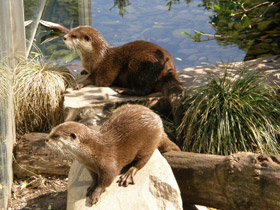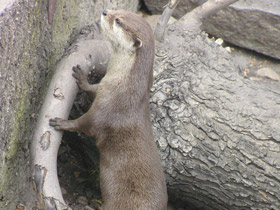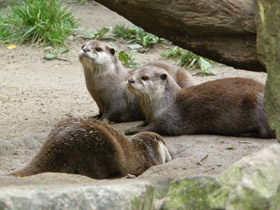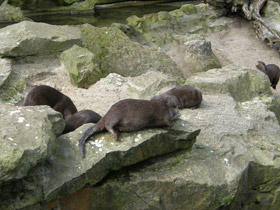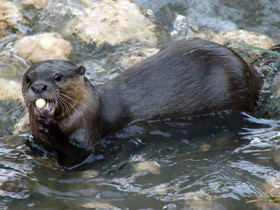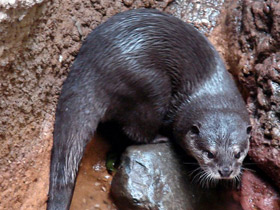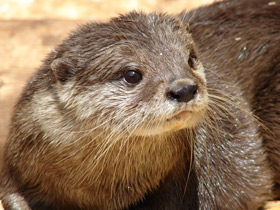The Asian small-clawed otter, the oriental small-clawed otter and the small-clawed otter (Aonyx cinereus)
The Asian small-clawed otter (Aonyx cinereus), also known as the oriental small-clawed otter and the small-clawed otter, is an otter species native to South and Southeast Asia. It has short claws that do not extend beyond the pads of its webbed digits. With a total body length of 730 to 960 mm (28.6 to 37.6 in), and a maximum weight of 5 kg (11 lb) it is the smallest otter species in the world.
The Asian small-clawed otter lives in riverine habitats, freshwater wetlands and mangrove swamps. It feeds on molluscs, crabs and other small aquatic animals. It lives in pairs, but was also observed in family groups with up to 12 individuals.
It is listed as Vulnerable on the IUCN Red List, and is threatened by habitat loss, pollution, and in some areas also by hunting.
Taxonomy
Lutra cinerea was the scientific name proposed by Johann Karl Wilhelm Illiger in 1815 for an otter collected in Batavia. In the 19th and 20th centuries, several zoological specimens were described:
- Lutra concolor proposed by Constantine Samuel Rafinesque in 1832 was a uniform coloured otter from Assam. Rafinesque also proposed Amblonyx as name for a subgenus for otters with short, obtuse claws.
- Lutra leptonyx proposed by Thomas Horsfield in 1824 were two adult small-clawed otters collected in Java. It was subordinated to the genus Aonyx by John Edward Gray in 1843.
- Amblonyx cinerea nirnai proposed by Reginald Innes Pocock in 1940 was a dark brown small-clawed otter from Virajpet in South India.
Habitat and appearance
Aonyx cinereus is a species of carnivorous mammal in the family Mustelidae.
Aonyx cinereus is common in the mangroves and freshwater swamps of Indonesia, southern China, southern India, Malaysia, Indonesia, New Guinea and the Philippines.
It is the smallest of the thirteen otter species, with a body length of 45-61 cm and a weight of 1-5 kg.
Aonyx cinereus has an elongated body on short legs, with the front legs slightly shorter than the hind legs. Compared to other otters, the body is somewhat shorter and thicker, giving it a cat-like appearance.
The fur of Aonyx cinereus is brown, while its throat, chin and cheeks are pale cream or beige. Unlike aquatic mammals (seals), most otters do not have a fat reserve, so they owe their warmth and dryness to the exceptional properties of their fur. But Aonyx cinereus does have a fat reserve, and it is this reserve that makes their bodies thick.
The head of the Aonyx cinereus is flat, broad and rounded, its thick whiskers detect vibrations in the water and sense the slightest change in currents, helping it to locate its prey. The eyes of this predator are set high on the head, close together and much larger than those of other otters, but its ears are small, rounded and set on the side of the head, and the ear canals are closed with membranes when the animal dives.
The molar teeth of Aonyx cinereus are large and flat, adapted for crushing shells. It also has large fangs, but the otter does not use them for hunting but for defence. The claws are not completely absent; small remnants of them are preserved on the footpad. The forelegs of Aonyx cinereus are unique: they resemble a hand and are only partially webbed. The toes are used to catch prey, which is unusual for other species. Aonyx cinereus has excellent eyesight and can see equally well on land and underwater. When swimming, its hind legs act as a propeller in the water and its tail serves as a rudder.
Nutrition
Aonyx cinereus is carnivorous and feeds on aquatic animals, crabs, snails, lobsters, clams and frogs. Aonyx cinereus finds prey by clawing at the bottom, digging in benthic mud and overturning rocks. With their legs, they tear their prey to pieces before putting them in their mouths. They usually hunt during the day.
Social behaviour and reproduction
Aonyx cinereus live in monogamous pairs that are constant throughout their lives. Males and females reach sexual maturity at the age of 2-3 years, and the female bears 2-3 young for about 60 days. Females may produce two litters each year. The young are born naked and helpless, and their eyes open at 40 days. The male brings prey for the mother and young until they begin to hunt on their own. At 9 weeks of age, they begin to swim and at 80 days they eat the same food as adult animals. Many otters stay with their parents after reaching physical maturity.
Aonyx cinereus are very social animals, and one of their favourite forms of communication is play. They tease each other, chase each other, mimic fights and roll down muddy hills. The eastern Aonyx cinereus cinereus is not yet endangered. However, many otters are killed by hunters, fishing nets, river pollution and habitat destruction. The species is included in the Species Survival Programme, which aims to breed otters in zoos.
Threats
The Asian small-clawed otter is threatened by poaching for its fur, loss and destruction of habitats such as hill streams, peat swamp forests and mangroves for aquaculture projects. Threats in India include deforestation, conversion of natural habitat for tea and coffee plantations, overfishing of rivers and water pollution through pesticides.
It is the most sought after otter species for the illegal pet trade in Asia. At least 711 Asian small-clawed otters were offered for sale through online websites by 280 traders in Indonesia, Thailand, Malaysia and Vietnam between 2016 and 2017. Between December 2015 and October 2018, 49 Asian small-clawed otters were confiscated from wildlife traffickers in Thailand, Vietnam and Japan; 35 of them were bound for sale in Japan.
Conservation
The Asian small-clawed otter was listed on CITES Appendix II and is protected in almost all range countries prohibiting its killing. Since August 2019, it is included in CITES Appendix I, thus strengthening its protection in regards to international trade.
In captivity
The Association of Zoos and Aquariums established a Species Survival Plan for the Asian small-clawed otter in 1983 to encourage research on captive breeding.
In Europe, Zoo Basel keeps Asian small-clawed otters together with Indian rhinoceros.
Asian small-clawed otters suffering from osteoporosis display resorption of hyperactive bone and cartilage by osteoclasts in many bone sites, which causes pockmarks on all the bones.









